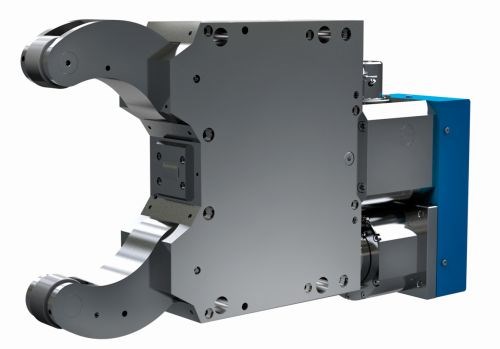e-Technology Energizes the Future of Gripping and Clamping
This clamping and gripping system incorporates electrically powered steady rests, clamping heads, grippers, cylinder systems, clamp release units and tool locking systems.
To conserve energy and reduce costs, shops and machine tool builders are increasingly shying away from hydraulics and pneumatics and are instead opting for gripping and clamping systems powered by electricity. This growing e-technology, while not likely to spell the complete extinction of hydraulics and pneumatics, provides a look into the future in terms of efficient, precise, compact and low-maintenance solutions.
One company taking a lead in this form of e-technology is Röhm GmbH, a manufacturer of clamping and gripping products that specializes in the development of electro-mechanical systems for the metalworking industry. The company has recently released its e-Quipment line of clamping and gripping systems to make the concept of all-electric machine tools a reality. The line incorporates electrically powered steady rests, clamping heads, grippers, cylinder systems (with and without through holes), clamp release units and tool locking systems.
The latest innovation in the e-Quipment range of tools is the EVS 50 electrical clamping system that activates power chucks on turning and grinding machines, minus any hydraulics or pneumatics. The EVS combines the strengths of mechanics with the precision control of electronics and operates on a standard external servomotor with 1.0 kW of power, making the unit compatible with several industry standard CNC machine controls.
Also new to the e-Quipment line is a servomotor-driven electrical steady rest and an electrical clamp release unit. With NC controlled functionality, the steady rest—designed for turning and grinding machines—rigidly clamps and supports long, shaft-type workpieces with ODs measuring between 15 and 170 mm.
Röhm’s compact electrical clamp release unit, in combination with the company’s Super Lock system, allows for the implementation of space-saving spindles. This combination is designed to provide users with a clamping system well suited for extremely high rotational speeds.
Other technologies within the e-Quipment Series include an electrical clamping head and an electrical gripper. On the clamping head, electricity initiates system release, and the integrated transmission to the drawdown forces increases the spring-operated tension by three or four fold. The clamping head’s control then returns the unit to the exact final position with predefined force.
Röhm’s electrical gripper is designed for energy efficiency and flexibility. It is suitable as an economic servo axis with integrated propulsion and stable role guidance—for workholding during burnishing or bending operations, for instance. The unit also works well for conventional clamping because it grips parts of various sizes without need for modification.
No matter how the electrical gripper is applied, it delivers cycle times as fast as 70 milliseconds per clamping process. Its flexible clamping power range of 10 N to 400 N enables both delicate handling and powerful clamping through an integrated sensor.
Machine tools equipped with electric clamping or gripping systems generally consume less energy. Unlike hydraulic clamping cylinders that require constant power to maintain necessary operating pressure, electrical clamps use energy only when in actual use—typically to run the short duration of the clamp and release cycle or when clamping force modifications are needed. As a result, in the course of a year and based on three shifts of operation, a shop could potentially save as much as 13,000 kWh—the approximate power consumption of four small family households—on one machine tool.
In addition to energy savings, electro-mechanical clamping systems can deliver increased part accuracy through faster and more precisely controlled clamping. Because they are easily regulated via machine tool controls, the systems allow shops to optimize holding force and lift while a workpiece is being processed.
Because clamping force can be adjusted during actual workpiece rotation, shops can, for example, reduce the tensile force and pressure of the electronic clamp for finish turning operations to eliminate the risk of workpiece deformation. This capability to precisely regulate clamping force on-the-fly allows processing of extremely delicate parts with maximum accuracy.
When electrical components replace larger ones associated with hydraulics and pneumatics, the result is a more compact, space-saving clamping and gripping system that requires minimal maintenance. Shops eliminate the need to clean, replace or dispose of hydraulic fluids and avoid any risk of environmental contamination from system leakage. The absence of hydraulics also makes for a clean, oil-free and quieter working environment.
As the development of these electro-mechanical systems continues to move forward, benefits will become apparent in machine tools that consume less energy, require minimal maintenance and are more environmentally friendly.
Related Content
Making Micro Threads
Production of micro threads can be challenging, but using the most suitable tools for a given application can simplify the task.
Read MoreBreaking the Barriers for Small Tool Breakage Detection
This contact-free tool breakage detector, especially useful for machine tools with small tools and small workzones, offers a quick and efficient way to change out broken tools before they cause bigger problems.
Read MoreReplaceable-Insert Spade Drill Basics, Advantages
Although solid carbide and indexable-insert drills have their place in a machine shop, replaceable-insert spade drills offer specific advantages for various holemaking operations on machining centers and lathes.
Read MoreBroaching Tool Technology For Lathes Used to Slot Inconel Parts
This shop finds value in using an indexable-insert-style broaching tool to create blind-hole slots in heat-treated Inconel aerospace parts on a CNC lathe.
Read MoreRead Next
The Many Sides of Workholding
Here's a broad look at different ways to approach workholding, from bar feeders to collet chucks to robotics.
Read MoreDo You Have Single Points of Failure?
Plans need to be in place before a catastrophic event occurs.
Read MoreA Tooling Workshop Worth a Visit
Marubeni Citizen-Cincom’s tooling and accessory workshop offers a chance to learn more about ancillary devices that can boost machining efficiency and capability.
Read More.png;maxWidth=970;quality=90)
























